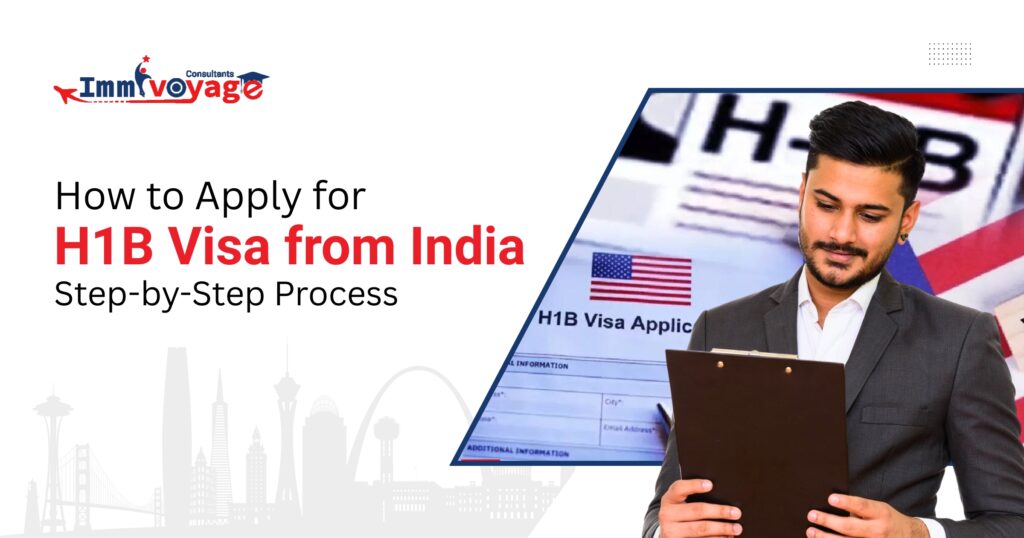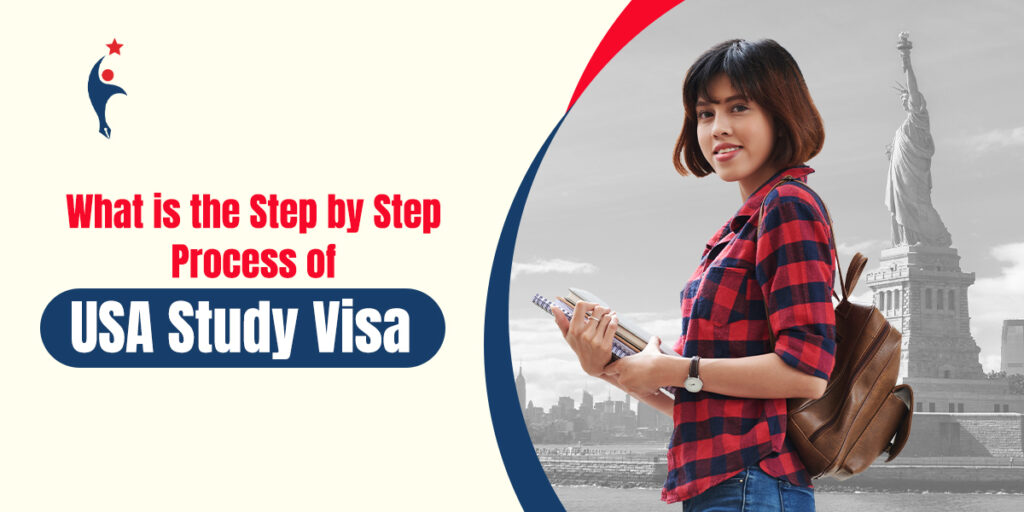For many Indians, working in the United States is a big dream, and the H1B visa is often the key to making that dream come true. This visa not only opens the door to many career opportunities in top U.S. companies but also provides a way to long-term residency.
So, if you’re planning to apply for the H1B visa, then it’s important to understand what this visa is, its requirements, the step-by-step process, the costs involved, and the latest 2025 updates. This blog will break everything down for you so that you can successfully apply for this visa.
What is an H1B Visa?
The H1B visa is a non-immigrant visa that lets U.S. employers to hire skilled foreign employees in specialty occupations. This means that U.S. employers can hire the best talent from all around the world to boost their growth and success.
To apply, you must first secure a job offer from a US-based employer, as the employer is responsible for sponsoring your visa. These jobs usually require at least a bachelor’s degree in fields like IT, engineering, finance, healthcare, or research.
Moreover, the U.S. government uses a lottery system to select applications each year for this visa.
What are the Benefits of an H1B Visa?
The H1B visa USA is one of the most popular work visas, as it opens the doors to high-paying jobs and gives your family a chance to build a future in America. Here are some of the benefits that you get from an H1B visa:
1. A Chance to Work in the U.S.
The biggest advantage of the H1B visa is the chance to work in the United States. Many of the world’s top companies in technology, finance, healthcare, and research are in the U.S. and hire H1B workers.
This means you have access to well-paying jobs, chances to work on international projects, and the chance to build skills that are recognized globally.
2. Option to Bring Your Family Along
H1B holders can bring their spouse and children (under 21 years) on an H4 dependent visa. Families can live together in the U.S. during the visa period.
In many cases, spouses on H4 visas are eligible for work authorization, which means they can also find jobs and contribute financially. Children can study in American schools and universities without needing a separate student visa.
3. Green Card Opportunity
Another major benefit is the opportunity to apply for permanent residency. Many U.S. employers are willing to sponsor their H1B employees for a Green Card, which allows you to live and work in the U.S. without time limits.
This makes the H1B an important first step for those planning a long-term future in America.
4. Career Growth and Global Exposure
Working in the U.S. gives you access to advanced technology, international teams, and global networks. The experience that you gain through an H1B visa not only boosts your salary but also makes your profile stronger in the global job market.
It’s a chance to grow faster in your career compared to opportunities available back home.
What are the Eligibility Requirements for an H1B Visa?
Before you go and start to apply for an H1B visa, there are certain requirements that you need to qualify for first. These H1B requirements ensure that only qualified professionals get this visa. Here are the H1B visa requirements:
1. A Job Offer in a Specialty Occupation: The first step is having a job offer from a U.S. employer. The job must be a specialty occupation, which means you’ll need a bachelor’s degree or higher in a relevant field.
2. Education: Indian applicants need the right degree for the job:
- A bachelor’s degree or higher in a field that relates to the job.
- If the degree is from outside the U.S., it must be evaluated to check if it’s equal to a U.S. degree.
- In some cases, strong work experience in the field can be counted in place of a degree.
3. Employer Willing to File the Petition: The employer must first file the H1B petition for the applicant. They also need to prove they can pay the required salary and that hiring a foreign worker will not hurt the working conditions of U.S. employees.
4. Labor Condition Application (LCA): Before filing the petition, the employer must get an LCA approved by the Department of Labor. This confirms that the worker will be paid fairly and that the job meets U.S. labor rules.
5. Following U.S. Immigration Rules: Both the employer and the applicant must follow all rules. They need to provide correct information and let authorities know if there are any big changes in your application, like moving to a new location or changing job duties.
For more details on the requirements for this visa, you can visit the official website of the U.S. government.
What Documents are Required for an H1B Visa?
Gathering the right documents is one of the first real steps in the H1B process. This section covers exactly what documents you and your employer need to submit, so there are no surprises during filing or at the U.S. embassy.
The following are the H1B visa documents required from the applicant:
- A valid passport
- Copies of your educational certificates (degrees, diplomas, transcripts)
- Your updated resume or CV
- Letters showing your previous work experience
- Passport-size photographs (as per U.S. visa guidelines)
- Completed visa application forms
- H1B petition approval notice
For your employer, they’ll need to provide:
- They’re have a certified Labor Condition Application (LCA) from the Department of Labor
- The H1B petition form (Form I-129)
- The official job offer letter
- Company tax documents and proof of business operations
Make sure to double-check with your employer and the U.S. consulate for any extra documents needed for your specific case. Keeping everything organized will make the process much smoother!
How to Apply for an H-1B Visa Step-By-Step?
Getting an H1B visa can feel a little complicated, but with the right guidance, you can apply for it with confidence.
The process has several steps, most of which your employer handles, so knowing what paperwork is needed, how long things usually take, and where problems can come up will make everything much smoother.
Here’s the step-by-step H1B visa process:
Step 1: Employer Registration with USCIS
The very first step in your visa is for your employer to get you registered for the H1B lottery. This step is mandatory, and without registration, your application can’t move forward, and there is no way to enter the lottery.
- Employer submits your full name, passport details, and educational information.
- The employer pays a $215 registration fee.
- Accuracy is extremely important; even a minor typo in your name or passport number can disqualify your registration.
Tip: Always double-check every detail before submission. Save the registration confirmation email as proof in case of any discrepancies later.
Step 2: H1B Visa Lottery Selection
Because more candidates apply than available visas, USCIS conducts a random lottery system to select registrations. This is the stage that determines whether your employer can proceed with filing the full petition.
- 65,000 visas are available under the regular cap.
- 20,000 visas are set aside for candidates with a U.S. master’s or higher degree.
- If your registration is picked, your employer can submit the full petition; however, being selected in the lottery does not guarantee approval, it only allows you to move to the next step.
Tip: Many applicants are not selected the first time, so it’s important to have a backup plan. This could include OPT extensions, other job offers or reapplying next year.
Step 3: Filing Form I-129 Petition
Once selected in the lottery, your employer files Form I-129, also called the Petition for a Non-immigrant Worker, with USCIS. This petition is the core of your application and demonstrates that you meet the qualifications for the specialty occupation.
Documents typically included:
- Passport copy
- Degree certificates and transcripts
- Credential evaluation (if foreign degree)
- Work experience letters and resume/CV
- Job offer letter and detailed job description
- Approved Labor Condition Application (LCA)
Tip: Ensure that your job description clearly aligns with your degree. USCIS reviews specialty occupations carefully, and vague job descriptions can result in a Request for Evidence (RFE) or denial.
Step 4: USCIS Review & Approval
After the petition is submitted, USCIS reviews it to ensure all requirements are met. This includes checking your qualifications, verifying the job role, and confirming the employer meets all legal requirements.
- Sometimes USCIS issues a Request for Evidence (RFE) if additional documents are needed or if something is unclear.
- Once approved, you will receive Form I-797, the official approval notice needed for the visa stamping process.
Tip: Respond promptly to any RFE to avoid delaying your approval and your start date.
Step 5: Get Your Visa Stamped at the U.S. Embassy in India
With your Form I-797 in hand, you can schedule a visa interview at a U.S. Embassy or Consulate in India. The interview is an important step where visa officers will check your documents and ask you questions about your job, employer, and qualifications.
- Essential documents include your passport, Form I-797, job offer letter, degree certificates, and experience letters.
- If everything is in order, the H1B visa is stamped on your passport, which allows you to travel to the U.S.
Tip: Prepare answers for basic questions about your job and employer, interviews are usually short but important and being well-prepared reduces stress.
How Much Does the H1B Visa Cost?
Some costs of an H1B visa are paid by the employer, and some are paid by the applicant. Many new updates have come this year regarding the payments, and it’s important that you understand these costs. Here’s the full breakdown of H1B visa cost:
| Fee Type | Cost (USD) | Who Pays | Notes |
| Registration Fee | $215 | Employer | Increased from $10 in 2025. Applies to all H1B registrations. |
| USCIS Petition (Form I-129) | ~$780 | Employer | Base filing fee for the petition. |
| New One-Time Fee (Effective Sept 21, 2025) | $100,000 | Employer | Applies only to new H1B petitions; not renewals. |
| Premium Processing (Optional) | $2,805 | Employer | For expedited processing of the petition. |
| Visa Stamping & Travel Costs | Varies | Applicant | Includes embassy fees, medical exams, and travel expenses. |
Final Words
Getting an H1B from India isn’t easy, but it’s achievable. Despite higher fees and stricter rules, this visa continues to be in huge demand because of the career opportunities and pathway to permanent residency it offers.
Applicants should prepare documents early, ensure their job offer directly matches their qualifications, and work with employers who are ready to handle the increased costs. With proper planning and the right employer, the H1B visa can still be the first big step toward building a career and future in the United States.



